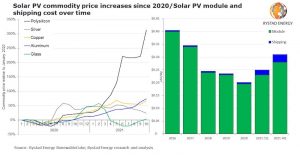The surging cost of manufacturing materials and shipping could threaten 50 GW — a staggering 56% — of the 90 GW of global utility PV developments planned for 2022, a Rystad Energy analysis shows. Commodity price inflation and supply chain bottlenecks could lead to the postponement or even cancellation of some of these projects, impacting demand and consumer pricing for solar-generated power.
Driven by core component price inflation, manufacturing costs for PV modules have surged from below $0.20 per watt peak (Wp) in 2020 to between $0.26 and $0.28 per Wp in the second half of 2021 — a near 50% increase in a year.
A significant driver of this surge is a more than 300% hike in the cost of polysilicon, a core component in PV manufacturing. In addition, other raw materials — silver, copper, aluminum and glass — have also climbed steadily since January 2020, increasing the pressure on module prices.
“The utility solar industry is facing one of its toughest challenges just days ahead of COP26. The current bottlenecks are not expected to be relieved within the next 12 months, meaning developers and offtakers will have to decide whether to reduce their margins, delay projects or increase offtake prices to get projects to financial close,” says David Dixon, senior renewables analyst at Rystad Energy.
In the United States, additional module tariffs also hang in the balance. The International Trade Commission is preparing to hold a public hearing next week on the prospect of extending Section 201 safeguard relief for crystalline silicon photovoltaic (CSPV) cells and modules, while the Commerce Dept. is in the midst of a separate investigation into Chinese silicon solar panel manufacturing companies working in Malaysia, Thailand and Vietnam as a potential way to avoid AD/CV duties.

In addition to materials cost inflation, shipping is another element in the supply chain causing considerable challenges for developers and module suppliers. The cost of shipping continues to rise, playing more of a role in overall production capital expenditure. Before 2021, the cost of PV shipping had a minimal impact on the overall production cost. However, pandemic-era shipping delays and bottlenecks have resulted in a near 500% increase in prices, from $0.005 per Wp in September 2019 to $0.03 per Wp in October 2021.
Modules and their associated shipping costs typically comprise between a quarter and a third of the total project capex and together represent the single-largest item of a project’s cost. When the cost of modules — and shipping — increases, it can significantly impact project economics.
Rystad Energy performed a sensitivity analysis to determine the levelized cost of electricity (LCOE) for different plant sizes comparing last year’s module and shipping costs with current costs. The results show that the LCOE of new projects has increased by between 10% and 15%, a major cost bump for most of the projects planned for 2022. Seeing their projects at risk, developers may have to resort to negotiating higher power purchase agreements (PPA) or absorbing some of the cost inflation, accepting higher project costs and lower margins.






